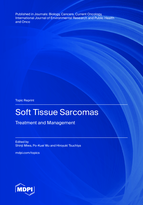Topic Menu
► Topic MenuTopic Editors

Soft Tissue Sarcomas: Treatment and Management

A printed edition is available here.
Topic Information
Dear Colleagues,
Due to the rarity and heterogeneity of soft tissue sarcoma, investigation into new treatments and methods of management has been challenging. Although intensive chemotherapy and the establishment of surgical procedures have improved the outcome of patients with soft tissue sarcomas, there remains limited options of anticancer agents, a high incidence of postoperative complications, and an unsatisfactory curative rate for recurrent and metastatic soft tissue sarcomas. The Special Issue aims to bring together the highest quality original/review articles on basic and clinical research into soft tissue sarcomas. Papers on molecular biology, the microenvironment, anticancer agents, and the management of soft tissue sarcomas are welcome.
Dr. Shinji Miwa
Dr. Po-Kuei Wu
Dr. Hiroyuki Tsuchiya
Topic Editors
Keywords
- soft tissue sarcoma
- treatment
- management
Participating Journals
| Journal Name | Impact Factor | CiteScore | Launched Year | First Decision (median) | APC |
|---|---|---|---|---|---|

Biology
|
4.2 | 4.0 | 2012 | 18.7 Days | CHF 2700 |

Cancers
|
5.2 | 7.4 | 2009 | 17.9 Days | CHF 2900 |

Current Oncology
|
2.6 | 2.6 | 1994 | 18 Days | CHF 2200 |

International Journal of Environmental Research and Public Health
|
- | 5.4 | 2004 | 29.6 Days | CHF 2500 |

Onco
|
- | - | 2021 | 18.3 Days | CHF 1000 |

MDPI Topics is cooperating with Preprints.org and has built a direct connection between MDPI journals and Preprints.org. Authors are encouraged to enjoy the benefits by posting a preprint at Preprints.org prior to publication:
- Immediately share your ideas ahead of publication and establish your research priority;
- Protect your idea from being stolen with this time-stamped preprint article;
- Enhance the exposure and impact of your research;
- Receive feedback from your peers in advance;
- Have it indexed in Web of Science (Preprint Citation Index), Google Scholar, Crossref, SHARE, PrePubMed, Scilit and Europe PMC.

